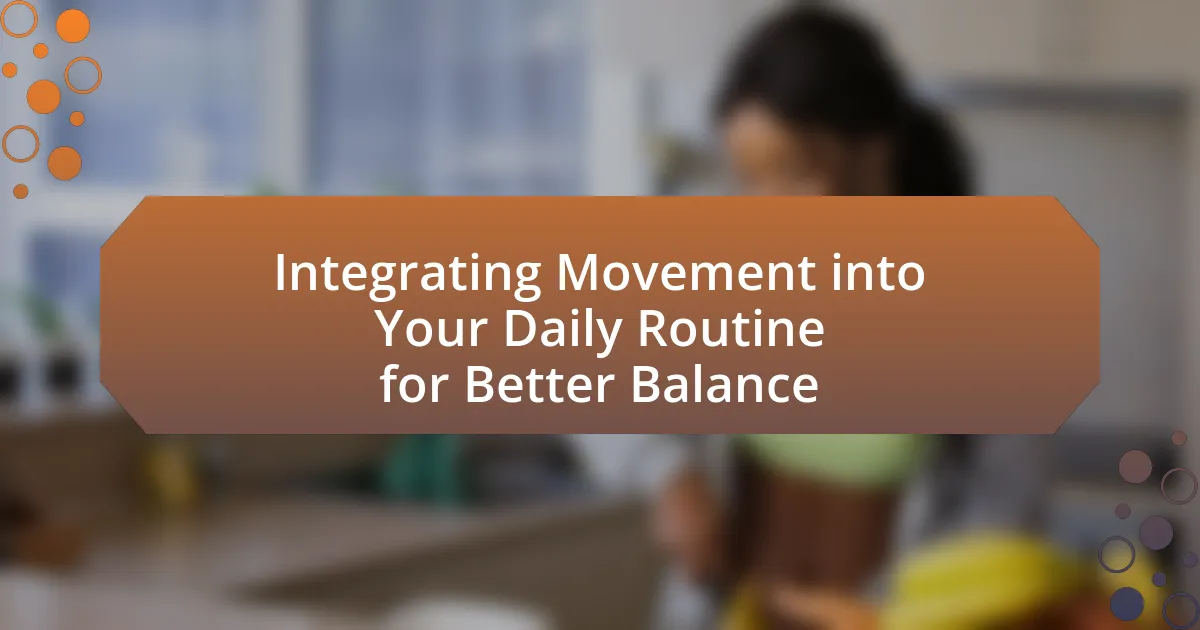Integrating movement into daily routines is essential for enhancing balance, stability, and overall physical health. The article outlines how regular physical activity, including exercises like yoga, tai chi, and simple movements such as walking or standing, can significantly improve muscle strength and proprioception, thereby reducing fall risk, especially in older adults. It discusses effective strategies for incorporating movement into busy schedules, the importance of creating a movement-friendly environment, and the role of technology in promoting daily activity. Additionally, the article addresses common challenges individuals face when trying to maintain a movement routine and offers practical solutions to overcome these barriers.

What does it mean to integrate movement into your daily routine for better balance?
Integrating movement into your daily routine for better balance means incorporating physical activities throughout your day to enhance stability and coordination. This can include simple actions such as standing up regularly, walking during breaks, or performing balance exercises like yoga or tai chi. Research indicates that regular movement can improve proprioception and muscle strength, which are crucial for maintaining balance. For instance, a study published in the Journal of Aging and Physical Activity found that older adults who engaged in consistent physical activity showed significant improvements in balance and reduced fall risk.
How can movement improve balance in daily life?
Movement can improve balance in daily life by enhancing muscle strength, coordination, and proprioception. Engaging in regular physical activities, such as walking, yoga, or strength training, activates the muscles that support balance and stability. Research indicates that exercises focusing on balance, like tai chi, can reduce the risk of falls by up to 47% in older adults, demonstrating the effectiveness of movement in maintaining balance. Additionally, consistent movement helps the brain develop better spatial awareness and body control, further contributing to improved balance in everyday activities.
What types of movements are most effective for enhancing balance?
The most effective movements for enhancing balance include single-leg stands, tai chi, yoga, and dynamic movements such as walking heel-to-toe. Single-leg stands improve stability by challenging the body’s ability to maintain equilibrium on one leg, which activates core and lower body muscles. Tai chi promotes balance through slow, controlled movements that enhance coordination and body awareness. Yoga incorporates various poses that strengthen muscles and improve flexibility, contributing to better balance. Dynamic movements like walking heel-to-toe train the body to adjust to shifting weight, further enhancing balance skills. Research indicates that these activities significantly reduce the risk of falls in older adults, demonstrating their effectiveness in balance enhancement.
How does regular movement influence overall physical stability?
Regular movement significantly enhances overall physical stability by improving muscle strength, coordination, and balance. Engaging in activities such as walking, stretching, and strength training activates various muscle groups, which contributes to better postural control and stability. Research indicates that individuals who participate in regular physical activity experience a reduction in falls and injuries, as evidenced by a study published in the Journal of Aging and Physical Activity, which found that older adults who engaged in consistent movement routines improved their balance and reduced fall risk by up to 30%. This correlation between regular movement and enhanced physical stability underscores the importance of integrating movement into daily routines for better balance.
Why is balance important in daily activities?
Balance is important in daily activities because it enhances stability and coordination, reducing the risk of falls and injuries. Maintaining balance allows individuals to perform tasks efficiently, such as walking, climbing stairs, and carrying objects. Research indicates that improved balance contributes to better overall physical health, as evidenced by a study published in the Journal of Aging and Physical Activity, which found that older adults who engaged in balance training experienced fewer falls and improved mobility. Thus, incorporating balance exercises into daily routines is essential for promoting safety and functional independence.
What are the risks associated with poor balance?
Poor balance significantly increases the risk of falls, which can lead to serious injuries such as fractures, head trauma, and even death. According to the Centers for Disease Control and Prevention (CDC), falls are the leading cause of injury-related deaths among older adults, with one in four experiencing a fall each year. Additionally, poor balance can result in decreased mobility and independence, leading to a higher likelihood of developing conditions such as depression and anxiety due to reduced physical activity and social interaction.
How does balance affect mobility and independence?
Balance significantly affects mobility and independence by enabling individuals to move safely and confidently. When balance is compromised, the risk of falls increases, which can lead to injuries and a subsequent decline in mobility. Research indicates that improved balance through exercises can enhance functional mobility, allowing individuals to perform daily activities independently. For instance, a study published in the Journal of Aging and Physical Activity found that older adults who engaged in balance training showed a 30% reduction in fall risk, thereby maintaining their independence longer. This evidence underscores the critical role of balance in facilitating safe movement and preserving autonomy in daily life.

What strategies can be used to incorporate movement into daily routines?
To incorporate movement into daily routines, individuals can implement strategies such as setting specific movement goals, utilizing reminders, and integrating physical activity into existing tasks. Setting goals, like aiming for 10,000 steps daily, provides a clear target that encourages consistent movement. Utilizing reminders, such as smartphone alerts or sticky notes, prompts individuals to take breaks for stretching or walking. Additionally, integrating movement into daily tasks, such as taking the stairs instead of the elevator or walking during phone calls, seamlessly incorporates physical activity into routine activities. Research indicates that even small increments of movement can significantly enhance overall physical health and well-being, supporting the effectiveness of these strategies.
How can you create a movement-friendly environment at home?
To create a movement-friendly environment at home, ensure that spaces are open and free of clutter to facilitate easy movement. This can be achieved by rearranging furniture to create clear pathways and designating areas for physical activities, such as stretching or yoga. Research indicates that environments promoting physical activity can significantly enhance overall movement levels, as noted in a study published in the Journal of Physical Activity and Health, which found that accessible spaces encourage more frequent movement. Additionally, incorporating items like stability balls, standing desks, and resistance bands can further promote active engagement throughout the day.
What simple changes can encourage more movement throughout the day?
Incorporating simple changes such as taking short walking breaks, using a standing desk, and opting for stairs instead of elevators can significantly encourage more movement throughout the day. Research indicates that breaking up prolonged sitting with brief periods of activity can enhance overall physical health and reduce the risks associated with sedentary behavior. For instance, a study published in the Journal of Physical Activity and Health found that individuals who engaged in short bouts of walking every hour experienced improved cardiovascular health and increased daily step counts.
How can technology assist in promoting daily movement?
Technology can assist in promoting daily movement by providing tools such as fitness trackers, mobile applications, and smart home devices that encourage physical activity. Fitness trackers monitor steps, heart rate, and calories burned, motivating users to reach daily movement goals; studies show that individuals using these devices increase their activity levels by an average of 27%. Mobile applications offer guided workouts, reminders, and challenges that engage users in regular exercise routines. Smart home devices can prompt users to stand or move at intervals, integrating movement into sedentary tasks. Collectively, these technologies create an environment that fosters and supports consistent physical activity.
What types of exercises can be easily integrated into a busy schedule?
High-intensity interval training (HIIT), bodyweight exercises, and short yoga sessions can be easily integrated into a busy schedule. HIIT workouts, which can be completed in as little as 15-30 minutes, provide effective cardiovascular and strength training benefits in a short time frame. Bodyweight exercises, such as push-ups, squats, and lunges, require no equipment and can be performed anywhere, making them convenient for quick workouts. Additionally, short yoga sessions, often lasting 10-20 minutes, can enhance flexibility and reduce stress, fitting seamlessly into breaks during the day. These exercise types are supported by research indicating that even brief, high-intensity workouts can yield significant health benefits, making them ideal for individuals with limited time.
How can short bursts of activity be effective for balance?
Short bursts of activity can be effective for balance by enhancing neuromuscular coordination and improving proprioception. Engaging in brief, high-intensity exercises activates the muscles and nervous system, which helps to refine the body’s ability to maintain stability. Research indicates that activities like quick balance drills or agility exercises can lead to significant improvements in balance performance, particularly in older adults. A study published in the Journal of Aging and Physical Activity found that participants who engaged in short, frequent bouts of balance training showed a 30% improvement in balance-related tasks compared to those who did not. This evidence supports the effectiveness of integrating short bursts of activity into daily routines to enhance balance.
What are some examples of quick exercises that improve balance?
Some examples of quick exercises that improve balance include single-leg stands, heel-to-toe walks, and tai chi movements. Single-leg stands involve balancing on one leg for 10-30 seconds, which enhances stability and strengthens the supporting leg. Heel-to-toe walks require walking in a straight line, placing the heel of one foot directly in front of the toes of the other, promoting coordination and balance. Tai chi movements, characterized by slow, controlled motions, have been shown to improve balance and reduce fall risk, particularly in older adults. These exercises can be performed in short sessions throughout the day, making them easy to integrate into daily routines.

What are the best practices for maintaining a balanced movement routine?
The best practices for maintaining a balanced movement routine include incorporating a variety of exercises that target strength, flexibility, and cardiovascular fitness. Engaging in strength training at least twice a week helps build muscle and support joint health, while flexibility exercises, such as stretching or yoga, enhance range of motion and prevent injuries. Additionally, including aerobic activities, like walking or cycling, promotes cardiovascular health and endurance. Research indicates that a well-rounded routine can improve overall physical performance and reduce the risk of chronic diseases, as supported by the American Heart Association’s guidelines recommending at least 150 minutes of moderate-intensity aerobic activity weekly. Regularly assessing and adjusting the routine based on personal goals and physical feedback ensures continued progress and balance.
How can you track your progress in integrating movement?
To track your progress in integrating movement, utilize a combination of self-assessment tools, activity logs, and wearable technology. Self-assessment tools, such as questionnaires or checklists, can help you evaluate your movement habits and identify areas for improvement. Activity logs allow you to record daily movement activities, providing a clear picture of your consistency and engagement over time. Wearable technology, like fitness trackers, can quantify your physical activity levels, offering real-time data on steps taken, calories burned, and overall movement patterns. Research indicates that individuals who regularly monitor their physical activity are more likely to achieve their movement goals, as evidenced by a study published in the Journal of Physical Activity and Health, which found that self-monitoring significantly enhances adherence to exercise programs.
What tools or apps can help monitor daily activity levels?
Fitness trackers such as Fitbit, Garmin, and Apple Watch effectively monitor daily activity levels. These devices track steps, heart rate, and calories burned, providing users with real-time data on their physical activity. Additionally, smartphone apps like Google Fit and MyFitnessPal offer similar functionalities, allowing users to log activities and set fitness goals. Research indicates that using these tools can lead to increased physical activity and improved health outcomes, as they encourage users to stay active and monitor their progress consistently.
How often should you reassess your movement routine for balance?
You should reassess your movement routine for balance every 4 to 6 weeks. This timeframe allows for the evaluation of progress and adjustments based on changes in strength, flexibility, and overall balance capabilities. Regular reassessment is supported by research indicating that consistent evaluation helps in identifying areas needing improvement and adapting routines to meet evolving physical needs.
What tips can help sustain motivation for daily movement?
To sustain motivation for daily movement, set specific, achievable goals that provide a clear direction. Research indicates that individuals who establish concrete objectives are more likely to maintain their exercise routines, as these goals create a sense of purpose and accomplishment. Additionally, incorporating variety into your movement routine can prevent boredom and keep engagement high; studies show that diverse activities can enhance enjoyment and adherence to physical activity. Lastly, tracking progress through apps or journals can reinforce motivation by visually demonstrating improvements over time, which has been shown to increase commitment to regular movement.
How can setting goals enhance your commitment to movement?
Setting goals enhances commitment to movement by providing clear targets and motivation to achieve them. When individuals establish specific, measurable, achievable, relevant, and time-bound (SMART) goals, they create a structured framework that guides their actions and fosters accountability. Research indicates that goal-setting can lead to a 20-25% increase in performance, as individuals are more likely to engage in regular physical activity when they have defined objectives. This structured approach not only helps in tracking progress but also reinforces the habit of movement, making it an integral part of daily routines for better balance.
What role does social support play in maintaining a movement routine?
Social support plays a crucial role in maintaining a movement routine by enhancing motivation and accountability. Individuals who receive encouragement from friends, family, or community groups are more likely to adhere to their physical activity plans. Research indicates that social support can lead to increased exercise frequency and duration, as individuals feel more committed when they have a support system. For instance, a study published in the Journal of Physical Activity and Health found that participants with strong social networks were 50% more likely to engage in regular physical activity compared to those without such support. This demonstrates that social connections significantly influence the sustainability of movement routines.
What common challenges might arise when integrating movement into daily life?
Common challenges that arise when integrating movement into daily life include time constraints, lack of motivation, and physical limitations. Time constraints often stem from busy schedules, making it difficult for individuals to allocate time for physical activity. Lack of motivation can hinder consistent movement, as individuals may struggle to find enjoyable activities or set achievable goals. Physical limitations, such as injuries or chronic conditions, can restrict the types of movement that can be safely performed. These challenges are supported by research indicating that over 80% of adults do not meet recommended physical activity levels, often due to these barriers.
How can you overcome barriers to regular movement?
To overcome barriers to regular movement, individuals can establish a structured routine that incorporates physical activity into daily life. Research indicates that setting specific goals and scheduling movement, such as walking during lunch breaks or using reminders for activity, significantly increases adherence to exercise. A study published in the Journal of Physical Activity and Health found that participants who set clear, achievable goals were 50% more likely to engage in regular physical activity compared to those without structured plans. Additionally, addressing environmental factors, such as creating a dedicated space for exercise at home or utilizing community resources like parks, can further facilitate consistent movement.
What strategies can help manage time effectively for movement?
To manage time effectively for movement, individuals can implement strategies such as scheduling specific times for physical activity, setting reminders, and prioritizing movement within daily tasks. Scheduling dedicated time slots for exercise ensures that movement becomes a non-negotiable part of the day, similar to work meetings or appointments. Setting reminders can help prompt individuals to take breaks for movement, which is crucial for maintaining physical activity levels throughout the day. Prioritizing movement by integrating it into daily routines, such as walking during phone calls or using stairs instead of elevators, can also enhance overall activity levels. Research indicates that incorporating short bursts of movement into daily routines can significantly improve physical health and well-being, as evidenced by studies showing that even brief periods of activity can lead to better cardiovascular health and increased energy levels.
